I'm pretty excited about this! It feels like a major milestone. I'm excited to finish and paint the cabin top and overhead. Then I'll install the cabin top for good!
There was a lot prep work that went into this and I'll let my pics and daily tasks lay it all out.
Dates and Times
Tues 18 -1.5 hrs- Sanded canopy with 100grit to smooth everything out
Wed 19 -1.5 hrs- Same as yesterday
Thurs 20 -0.75 hrs- Same as yesterday and the day before that
Fri 21 -0.75 hrs- Sprayed with grey high build primer from spray can...same as before when I primed the overhead for the first time
Sat 22 -3.0 hrs- Sanded with 180 grit and then with 220 to get everything really smooth. Wiped it all down and sprayed the overhead first with a really dark grey color I picked out from Sherwin Williams exterior car paint. Both my colors are Range Rover exterior colors (not intentional...just happened that way).
Sun 23 -2.0 hrs- Taped/masked the overhead dark area and then sanded the rest with 220 to smooth out the overspray from yesterday. I then sprayed my really light tan color on the rest. I plan on installing a headliner so the entire top is not painted for that reason.
Original primer sanded down until smooth. Any pin holes filled...again.
After a second coat of primer and more sanding I sprayed my first color.
Masking and more sanding I sprayed my second color.
A close up of the lip. It all looks really good and the pictures don't do it justice. I'm really happy with the results...and of course you need to imagine the closeout panels installed. I'll have a few touch up details and the painting of the overhead will be complete.

I used Sherwin Williams Dimension paint. It is an Acrylic Enamel exterior car paint. The two cans on the right are the two color base paints. You mix the reducer and hardener per the instructions and then add the flattening agent (can on the left). I added an almost 1:1 ratio of paint to flattener to make an almost completely flat look. The finish has a slight "eggshell" reflection back....which is exactly what I had hoped for. I won't be spraying a clear coat.













































